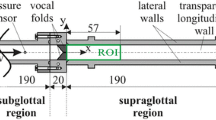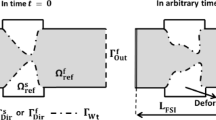Abstract
The aeroacoustic mechanisms in human voice production are complex coupled processes that are still not fully understood. In this article, a hybrid numerical approach to analyzing sound generation in human voice production is presented. First, the fluid flow problem is solved using a parallel finite-volume computational fluid dynamics (CFD) solver on a fine computational mesh covering the larynx. The CFD simulations are run for four geometrical configurations: both with and without false vocal folds, and with fixed convergent or convergent–divergent motion of the medial vocal fold surface. Then the aeroacoustic sources and propagation of sound waves are calculated using Lighthill’s analogy or acoustic perturbation equations on a coarse mesh covering the larynx, vocal tract, and radiation region near the mouth. Aeroacoustic sound sources are investigated in the time and frequency domains to determine their precise origin and correlation with the flow field. The problem of acoustic wave propagation from the larynx and vocal tract into the free field is solved using the finite-element method. Two different vocal-tract shapes are considered and modeled according to MRI vocal-tract data of the vowels /i/ and /u/. The spectra of the radiated sound evaluated from acoustic simulations show good agreement with formant frequencies known from human subjects.
















Similar content being viewed by others
References
Agarwal M, Scherer R, Hollien H (2003) The false vocal folds: shape and size in frontal view during phonation based on laminagraphic tracings. J Voice 17(2):97–113. doi:10.1016/S0892-1997
Agarwal M (2004) The false vocal folds and their effect on translaryngeal airflow resistance. Ph.D. thesis, Bowling Green State University
Alipour F, Jaiswal S, Finnegan E (2007) Aerodynamic and acoustic effects of false vocal folds and epiglottis in excised larynx models. Ann Otol Rhinol Laryngol 116(2):135–144
Alipour F, Brucker C, D Cook D, Gommel A, Kaltenbacher M, Mattheus W, Mongeau L, Nauman E, Schwarze R, Tokuda I, Zörner S (2011) Mathematical models and numerical schemes for the simulation of human phonation. Curr Bioinform 6(3):323–343. doi:10.2174/157489311796904655
Bae Y, Moon YJ (2008) Computation of phonation aeroacoustics by an INS/PCE splitting method. Comput Fluids 37(10):1332–1343. doi:10.1016/j.compfluid.2007.12.002
Bailly C, Juvé D (2000) Numerical solution of acoustic propagation problems using linearized Euler equations. AIAA J 38:22–29. doi:10.2514/2.949
Bailly L, Pelorson X, Henrich N, Ruty N (2008) Influence of a constriction in the near field of the vocal folds: physical modeling and experimental validation. J Acoust Soc Am 124(5):3296–3308. doi:10.1121/1.2977740
Boessenecker A, Berry DA, Lohscheller J, Eysholdt U, Döllinger M (2007) Mucosal wave properties of a human vocal fold. Acta Acust United Acust 93(5):815–823
Chevalier C, Pellegrini F (2008) PT-scotch: A tool for efficient parallel graph ordering. Parallel Comput 34(6–8):318–331. doi:10.1016/j.parco.2007.12.001
Ewert R, Schröder W (2003) Acoustic perturbation equations based on flow decomposition via source filtering. J Comput Phys 188(2):365–398. doi:10.1016/S0021-9991(03)00168-2
Feistauer M, Hasnedlová-Prokopová J, Horáček J, Kosík A, Kučera V (2013) DGFEM for dynamical systems describing interaction of compressible fluid and structures. J Comput Appl Math 254:17–30. doi:10.1016/j.cam.2013.03.028
Ferziger JH, Peric M (2002) Computational methods for fluid dynamics. Springer, Berlin. doi:10.1007/978-3-642-56026-2
Geuzaine C, Remacle JF (2009) Gmsh: a three-dimensional finite element mesh generator with built-in pre- and post-processing facilities. Int J Numer Methods Eng 79(11):1309–1331
Hüppe A (2014) Spectral finite elements for acoustic field computation (Measurement-, Actuator-, and Simulation-technology). Ph.D. thesis, Shaker Verlag GmbH, doi:10.2370/9783844024609
Hüppe A, Kaltenbacher M (2012a) Spectral finite elements for computational aeroacoustics using acoustic perturbation equations. J Comput Acoust 20(02):1240,005 1–13, doi:10.1142/S0218396X1240005X
Hüppe A, Kaltenbacher M (2012b) Stable matched layer for the acoustic conservation equations in the time domain. J Comput Acoust 20(01):1250,004. doi:10.1142/S0218396X11004511
Jasak H (1996) Error analysis and estimation for the finite volume method with applications to fluid flows. Ph.D. thesis, Imperial College of Science, Technology and Medicine, London
Kaltenbacher B, Kaltenbacher M, Sim I (2013) A modified and stable version of a perfectly matched layer technique for the 3-d second order wave equation in time domain with an application to aeroacoustics. J Comput Phys 235(0):407–422. doi:10.1016/j.jcp.2012.10.016
Kaltenbacher M (2007) Numerical simulation of mechatronic sensors and actuators. Springer, Berlin. doi:10.1007/978-3-540-71360-9
Kaltenbacher M, Escobar M, Ali I, Becker S (2010) Numerical simulation of flow-induced noise using LES/SAS and Lighthill’s acoustics analogy. Int J Numer Methods Fluids 63(9):1103–1122. doi:10.1002/fld.2123
Kelleher J, Siegmund T, Du M, Naseri E, Chan R (2013) Empirical measurements of biomechanical anisotropy of the human vocal fold lamina propria. Biomech Model Mechanobiol 12(3):555–567. doi:10.1007/s10237-012-0425-4
Li S, Wan M, Wang S (2007) The effects of the false vocal fold gaps in a model of the larynx on pressures distributions and flows. Digital human modeling, Springer, Berlin Heidelberg, pp. 147–156, doi:10.1007/978-3-540-73321-8_18
Lighthill M (1952) On sound generated aerodynamically. I. General theory. Proc R Soc Lond Ser A Math Phys Sci 211(1107):564–587. doi:10.1098/rspa.1952.0060
Link G, Kaltenbacher M, Breuer M, Döllinger M (2009) A 2D finite-element scheme for fluid-solid-acoustic interactions and its application to human phonation. Comput Methods Appl Mech Eng 198:3321–3334. doi:10.1016/j.cma.2009.06.009
McGowan R (1988) An aeroacoustic approach to phonation. J Acoust Soc Am 83(2):696–704. doi:10.1121/1.396165
Mittal R, Erath BD, Plesniak MW (2013) Fluid dynamics of human phonation and speech. Annu Rev Fluid Mech 45(1):437–467. doi:10.1146/annurev-fluid-011212-140636
Pickup BA, Thomson SL (2009) Influence of asymmetric stiffness on the structural and aerodynamic response of synthetic vocal fold models. J Biomech 42(14):2219–2225. doi:10.1016/j.jbiomech.2009.06.039
Powell A (1964) Theory of vortex sound. J Acoust Soc Am 36(1):177–195. doi:10.1121/1.1918931
Rivera O, Fürlinger K, Kranzlmüller D (2011) Investigating the scalability of OpenFOAM for the solution of transport equations and large eddy simulations. In: Proceedings of the 11th international conference on algorithms and architectures for parallel processing—Part II:121–130
Schenk O, Gärtner K (2004) Solving unsymmetric sparse systems of linear equations with PARDISO. Future Gener Comput Syst 20(3):475–487. doi:10.1016/j.future.2003.07.011
Scherer R, Shinwari D, Witt KD, Zhang C, Kucinschi B, Afjeh A (2001) Intraglottal pressure profiles for a symmetric and oblique glottis with a divergence angle of 10 degrees. J Acoust Soc Am 109(4):1616–1630. doi:10.1121/1.1333420
Schroeder W, Martin K (2004) The visualization toolkit. In: Hansen CD and Johnson CR (eds) Elsevier http://www.kitware.com/publications/item/view/958
Seo JH, Mittal R (2011) A high-order immersed boundary method for acoustic wave scattering and low-Mach number flow-induced sound in complex geometries. J Comput Phys 230(4):1000–1019. doi:10.1016/j.jcp.2010.10.017
Šidlof P, Švec JG, Horáček J, Veselý J, Klepáček I, Havlík R (2008) Geometry of human vocal folds and glottal channel for mathematical and biomechanical modeling of voice production. J Biomech 41(5):985–995. doi:10.1016/j.jbiomech.2007.12.016
Šidlof P, Doaré O, Cadot O, Chaigne A (2011) Measurement of flow separation in a human vocal folds model. Exp Fluids 51(1):123–136. doi:10.1007/s00348-010-1031-9
Šidlof P, Horáček J, Řidký V (2013) Parallel CFD simulation of flow in a 3D model of vibrating human vocal folds. Comput Fluids 80:290–300. doi:10.1016/j.compfluid.2012.02.005
Šidlof P, Zörner S, Hüppe A (2013a) Numerical simulation of flow-induced sound in human voice production. Procedia Eng. 61:333–340. doi:10.1016/j.proeng.2013.08.024
Story BH, Titze I, Hoffman EA (1996) Vocal tract area functions from magnetic resonance imaging. J Acoust Soc Am 100(1):537–554. doi:10.1121/1.415960
Tian FB, Dai H, Luo H, Doyle JF, Rousseau B (2014) Fluid-structure interaction involving large deformations: 3D simulations and applications to biological systems. J Comput Phys 258:451–469. doi:10.1016/j.jcp.2013.10.047
Titze IR (2006) The Myoelastic aerodynamic theory of phonation, 1st edn. National Center for Voice and Speech, Denver
Zhang C, Zhao W, Frankel S, Mongeau L (2002) Computational aeroacoustics of phonation, Part II: effects of flow parameters and ventricular folds. J Acoust Soc Am 112(5 Pt 1):2147–2154. doi:10.1121/1.1506694
Zhao W, Zhang C, Frankel S, Mongeau L (2002) Computational aeroacoustics of phonation, Part I: computational methods and sound generation mechanisms. J Acoust Soc Am 112(5 Pt 1):2134–2146. doi:10.1121/1.1506693
Zheng X, Bielamowicz S, Luo H, Mittal R (2009) A computational study of the effect of false vocal folds on glottal flow and vocal fold vibration during phonation. Ann Biomed Eng 37(3):625–642. doi:10.1007/s10439-008-9630-9
Zörner S, Kaltenbacher M, Lerch R, Sutor A, Döllinger M (2010) Measurement of the elasticity modulus of soft tissues. J Biomech 43(8):1540–1545. doi:10.1016/j.jbiomech.2010.01.035
Zörner S, Kaltenbacher M, Döllinger M (2013) Investigation of prescribed movement in fluid-structure interaction simulation for the human phonation process. Comput Fluids 86:133–140. doi:10.1016/j.compfluid.2013.06.031
Acknowledgments
This research was supported by the Czech Science Foundation, Project P101/11/0207 and by the Austrian Science Fund under Grant I 532-N20. The support of the Czech and Austrian agencies for international cooperation and mobility within ICM OeAD – MŠMT (Project CZ 09/2013–7AMB13AT006), which facilitates the effective cooperation of the authors, is also gratefully acknowledged. The CFD simulations were run at the facilities of the Supercomputer Center of the CTU in Prague, Czech Republic.
Author information
Authors and Affiliations
Corresponding author
Rights and permissions
About this article
Cite this article
Šidlof, P., Zörner, S. & Hüppe, A. A hybrid approach to the computational aeroacoustics of human voice production. Biomech Model Mechanobiol 14, 473–488 (2015). https://doi.org/10.1007/s10237-014-0617-1
Received:
Accepted:
Published:
Issue Date:
DOI: https://doi.org/10.1007/s10237-014-0617-1




